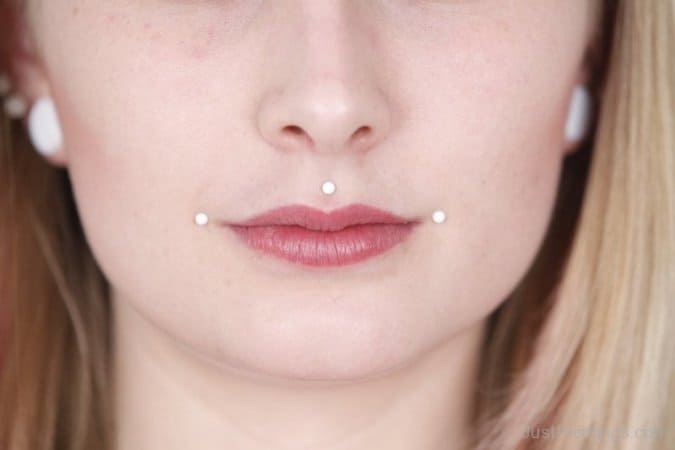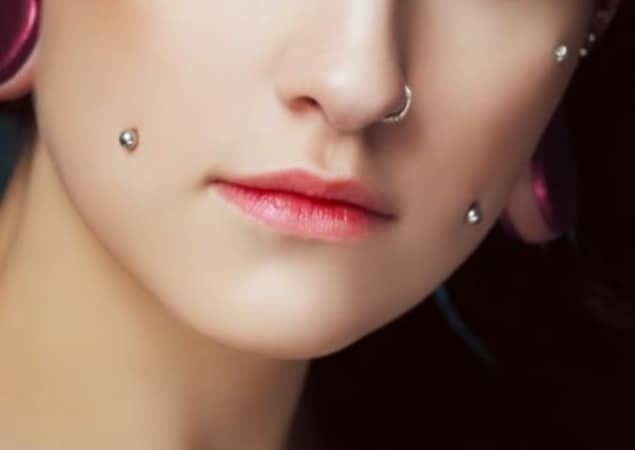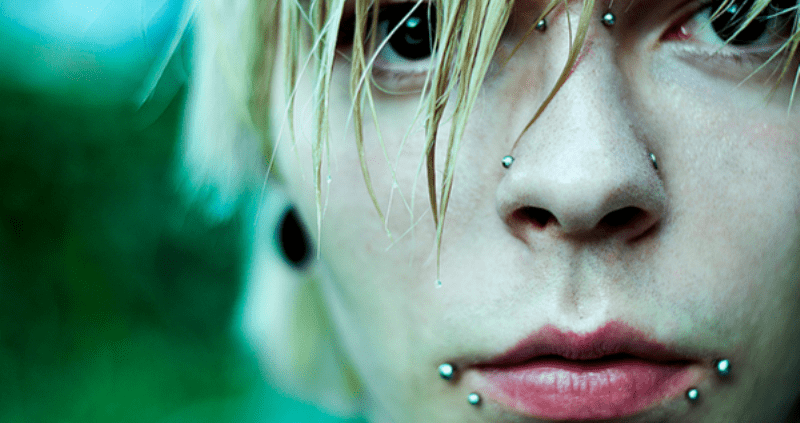Piercings are the name given to perforations in the body in which jewelry is inserted. Piercing is also defined as the process of making such perforations by inserting a needle into the skin of a body part.
This practice exists in human cultures since immemorial times. It is done for different reasons, the most common ones being religion and spirituality, self-expression and aesthetics.
However, the public display of body piercings is discouraged in many places, like offices, institutes or places of worship. This is emphasized when the piercings are numerous or unusually striking in appearance.
The most popularly widespread and accepted piercings are those on the earlobes and the nostril. But piercings have been found to be made on practically all the body parts, including as lips, eyebrows, tongue, chest, navel and genital areas.
As of now, piercing has become a type of business along with tattoos. It is done in specialized parlors that count with the required tools, standardized and sterile conditions, and skilled personnel for the procedure.
The process of piercing should be done with extreme care and with the consent of a medical advisor.
In addition, it is necessary to keep a proper maintenance and aftercare to avoid the risks associated with it like infections, allergies, or profuse bleeding; especially during the healing period.
This article will introduce you to a particular type of piercing, popularly known as “The Dahlias”. It contains information about its characteristic features, its uncommon location, the healing period, scars, and tips for its aftercare as well as its price.
Table of Contents
The Dahlia Piercing

The Dahlia piercing is a facial double piercing that is made on each corner of the mouth or near them.
It is also known as the “Dahlia bites”, “Joker piercing/bites”, double corner piercings or lip corner piercings.
The name “Dahlia” derives from the scandalously macabre “Black Dahlia” murder case in California that involved the slash of the face from the mouth corners to the ears among other forms of mutilation.
The name “Joker piercing” is inspired from the characteristics scars of the Batman series villain, The Joker.
This is a rather rare type of piercing due to the uncommon location and perhaps the ominous significance of its origin.
Opting for this piercing surely implies a bold statement.
Procedure – Getting The Piercing Done
The Dahlia piercings are quite uncommon and performed only in very specialized establishments. It is important to make sure that the well-trained professional is familiar with it.
Before finalizing a decision, keep in mind the pros and cons of this piercing style after gathering the maximum information about it.
These piercings are located at a very specific location, which is just slightly outside the mouth corners. It doesn’t and it shouldn’t through the lip tissue due to the risks that this conveys to the mouth.
It goes through the flesh of the cheek as close as possible to the lip corners to provide a lengthening effect, and placing it too far from them will result in a different piercing style altogether.
This gives us a hint of the importance of getting it done by an experienced and skilled piercer.
Steps To Follow
Before deciding to get a Dahlia piercing, make sure to consult a professional, skilled and experienced piercer. Get your mouth checked by them and let them give you any possible suggestions and advice.
They will confirm whether your mouth and the thickness and nature of the surrounding skin are suitable for this type of piercing, which is not the case for everyone.
Only after this go ahead with the actual piercing, whose procedure involves the following steps:
- Cleaning the corners of the mouth thoroughly to prevent the risk of infections.
- Carefully marking the exact spots to be perforated with a medical marker pen.
- Piercing each of the marked spots with a hollow needle that has been sterilized.
- Inserting labret jewelry (typically studs) into the holes that have been just made.
The whole process will naturally take a considerable longer amount of time than a single lip piercing as it involves two perforations and insertions as well as a very high amount of precision to be carried out.
PRICE – How Much Does It Cost?
This type of piercing is very particular and it is professionally done in highly specialized piercing studios.
The price of this piercing ranges from 50 to 80$, which converts to approximately 3,300 to 5,400 INR.
Pain – And Other Effects Of The Piercing
The insertion of a needle through the skin usually implies the feeling of pain (no matter how less it is and this kind of piercing is no exception.
Moreover, the Dahlia piercing is done on two spots of the face that are highly sensitive due to their rich supply of nerves.
The intensity of the pain varies significantly from person to person and it will gradually decrease with time. However, it is important to consider the probability of the following risks and effects of the piercing:
- Pain and bleeding during and after the piercing process, which may take a few weeks to reduce.
- Soreness, tenderness, and swelling of the area. This can make simple actions like smiling, eating or speaking become difficult during the first days after the piercing.
- Nerve injury, excessive salivation or infection are possible due to the uncommon location of the piercing.
- Infection might also occur because of improper cleaning of the mouth and the pierced region. It further causes swelling, redness, itching and pain.
- Erosion of the gums and teeth by the labret jewelry. This might happen due to the natural continuous movement of the lips and cheeks.
- Rejection and migration of the piercing if it is done too close to the mouth.
- Asymmetry if the precision is not optimum during the piercing process.
- Scarring of the skin in the perforated spots or nearby. The scars might fade once the healing is complete.
Dahlia Piercing Scars
The appearance of scars might take place due to any type of piercing. In fact, it may happen due to any type of injury or wound on the body skin.
Just as the pain, the scars vary from person to person. Sometimes the scars may be more prominent and profuse and they may take years to fade. Other times, the scars might be very light and might disappear within months.
The scars from piercings might be of a negligible size, or might be a big lump that over-grows resulting in a hypertrophic scar or keloid.
In the case of the Dahlia piercings, the scars are rather as small as the holes that have been made at the mouth corners in practically all the cases.
The appearance of a scar considerably depends on factors like:
a. The tools and jewelry used.
b. The occurrence of infections.
c. The self-repair ability of your body.
d. The smoothness of the healing phase.
e. The duration of the piercing on the skin.
A routine skin care will surely help in fading any type of scar on the skin.
Scars Can Be Prevented And Treated At Home By
- Make-up to make it less visible.
- Vitamin C & E tablets or topical oil to reduce the scar tissue and soothe the skin.
- Regular massages on the scarred are to reduce the rigidity of the scar and repair the skin.
- Gently rubbing a mixture of salt and hot water to aid healing and disinfection.
- Application of chamomile tea for a prolonged period of time to help soften the area.
Healing – Getting Used To The Piercing
The Dahlia bites might take a bit longer than the usual piercings to heal. This is attributed to the fact that it consists of two piercings at a time, done on very sensitive spots near the mouth.
It might take from twelve to twenty weeks to soothe and the initial phase might be characterized by irritation, swelling, redness, and sensitivity.
The initial studs can be replaced by the piercer after four to five weeks, once the swelling reduces.
The healing might be worsened and prolonged by touching or moving the jewelry in excess. On the other hand, it can be eased by a proper aftercare and preventive measures.
Aftercare – Taking Care Of It
All the lip piercings require intensive after-care. In this case, the measures should be doubled. The care should be extended to the interior and to the exterior of the mouth, as the piercing comes in contact with both surfaces.
Your aftercare process should include the following tips:
1. Use cotton ball dipped in warm saline water to clean the piercings and softly pat them dry with a paper towel.
2. Rinse your mouth with warm saline water or an alcohol-free, antibacterial, neutral mouthwash after every meal. Brush your teeth twice per day with a soft bristle toothbrush. Maintain a permanent optimum buccal hygiene.
3. Wash the piercing and the jewelry with an antibacterial soap and rinse thoroughly. Do it daily to avoid infections and complications. Do not touch the jewelry unless it is for cleaning purpose.
4. Avoid the contact of the piercings with cosmetics such as creams, lotions, ointments or make-up.
5. Avoid smoking, alcohol and excessively hot or spicy food, particularly during the first weeks.
6. Maintain an overall good hygiene and clean surroundings. Clothes, pillowcases, and bedsheets should be washed and replaced regularly.
7.The daily use of a natural cleanser such as warm sea salt soaks boosts the healing of the skin and prevents infections.
8. If the pain, irritation or tightness is excessively intense, do not hesitate in returning to the piecing center and asking for professional advice.
Jewelry – Making A Fashion Statement

The jewelry that is often used for Dahlia piercings includes Monroe or labret studs, captive bead rings or ball closure rings and curved barbells. Commonly used gauges are of 14-16g of weight and 13mm of length. A longer bar might be used by the piercer to accommodate for swelling.
Professional establishments and parlors count with a varied selection of accessories and piercing jewelry options. The choice basically depends on the comfort and the style preferences of the person that wears them.
It is recommended that the size and proportions of the jewelry are confirmed with the piercer for future shopping. However, jewelry should not be replaced nor removed before the completion of the healing.
Also Read
Smiley Piercing, Anti-Smiley Piercing: Healing, Infection, Risks, Pain & Aftercare
Microdermal Piercings: Things You Should Know Before Getting This Done
Monroe Lip Piercing: Pain, Scar, Infected Aftercare, Healing
Double Tongue Piercings: Procedure, Risks, Healing Time
Belly Button/Navel Piercing Infection:: Causes, Symptoms, Treatment
Medusa Piercing Swelling: Aftercare, Scar And Piercing Risks
Cartilage Piercing Infection: Causes, Symptoms, How To Get Of It
Snake Bites Piercing: Pain, Healing, How To Hide
Home Remedies To Get Rid Of Nose Piercing Pain
Home Remedies To Get Rid Of Infected Nose Piercing Bump
Infected Belly Button Piercing Symptoms, Causes, Cure
How To Treat Infected Nipple Piercing?





